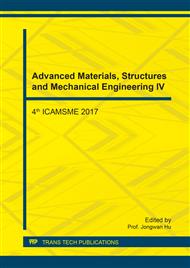[1]
H. Wang, Y. Yan, F. Jia, F. Han, Investigations of fracture on DP980 steel sheet in roll forming process, J. Manuf. Proc. 22 (2016) 177-184.
DOI: 10.1016/j.jmapro.2016.03.008
Google Scholar
[2]
S. Curtze, V. T. Kuokkala, M. Hokka, P. Peura, Deformation behavior of TRIP and DP steels in tension at different temperatures over a wide range of strain rates, Mater. Sci. Eng.: A, 507 (2009) 124-131.
DOI: 10.1016/j.msea.2008.11.050
Google Scholar
[3]
D. Wowk, K. Pilkey, An experimental and numerical study of prestrained AA5754 sheet in bending, J. Mater. Proc. Tech. 213 (2013) 1-10.
DOI: 10.1016/j.jmatprotec.2012.08.002
Google Scholar
[4]
M. Habibnejad-korayem, M. K. Jain, R. K. Mishra, Large deformation of magnesium sheet at room temperature by preform annealing, part II: Bending, Mater. Sci. Eng.: A, 619 (2014) 378-383.
DOI: 10.1016/j.msea.2014.09.096
Google Scholar
[5]
W. Xiong, W. Wang, M. Wan, X. Li, Geometric issues in V-bending electromagnetic forming process of 2024-T3 aluminum alloy, J. Manuf. Proc. 19 (2015) 171-182.
DOI: 10.1016/j.jmapro.2015.06.015
Google Scholar
[6]
M. Luo, T. Wierzbicki, Numerical failure analysis of a stretch-bending test on dual-phase steel sheets using a phenomenological fracture model, Int. J. Solid. Struct. 47 (2010) 3084-3102.
DOI: 10.1016/j.ijsolstr.2010.07.010
Google Scholar
[7]
J. C. Park, D. Y. Yang, M. Cha, D. Kim, J. B. Nam, Investigation of a new incremental counter forming in flexible roll forming to manufacture accurate profiles with variable cross-sections, Int. J. Mach. Tool. Manuf. 86 (2014) 68-80.
DOI: 10.1016/j.ijmachtools.2014.07.001
Google Scholar
[8]
Y. Yan, H. Wang, Q. Li, The inverse parameter identification of Hill 48 yield criterion and its verification in press bending and roll forming process simulations, J. Manuf. Proc. 20 (2015) 46-53.
DOI: 10.1016/j.jmapro.2015.09.009
Google Scholar
[9]
A. Abvabi, B. Rolfe, P. Hodgson, M. Weiss, The influence of residual stress on a roll forming process, Int. J. Mech. Sci. 101 (2015) 124-136.
DOI: 10.1016/j.ijmecsci.2015.08.004
Google Scholar
[10]
B. S. Bidabadi, H. M. Naeini, R. A. Tafti, S. Mazdak, Experimental investigation of the ovality of holes on pre-notched channel products in the cold roll forming, J. Mater. Proc. Tech. 225 (2015) 213-220.
DOI: 10.1016/j.jmatprotec.2015.06.008
Google Scholar
[11]
Y. Yan, H. Wang, Q. Li, B. Qian, K. Mpofu, Simulation and experimental verification of flexible roll forming of steel sheets, Int. J. Adv. Manuf. Tech. 72 (2014) 209-220.
DOI: 10.1007/s00170-014-5667-0
Google Scholar
[12]
S. GmbH. Metal forming handbook, Springer Science & Business Media, (1998).
Google Scholar
[13]
S. Panton, J. Duncan, S. Zhu, Longitudinal and shear strain development in cold roll forming, J. Mater. Proc. Tech. 60 (1996) 219-224.
DOI: 10.1016/0924-0136(96)02333-3
Google Scholar
[14]
M. Weiss, B. Abeyrathna, B. Rolfe, A. Abee, H. Wolfkamp, Effect of coil set on shape defects in roll forming steel strip, J. Manuf. Proc. 25 (2017) 8-15.
DOI: 10.1016/j.jmapro.2016.10.005
Google Scholar
[15]
O. M. Badr, B. Rolfe, P. Hodgson, M. Weiss, Forming of high strength titanium sheet at room temperature, Mater. Des. 66 (2015) 618-626.
DOI: 10.1016/j.matdes.2014.03.008
Google Scholar
[16]
L. Troive, L. Ingvarsson, Roll forming and the benefits of ultrahigh strength steel, Ironmak. Steelmak. 35 (2008) 251-253.
DOI: 10.1179/174328108x301714
Google Scholar


